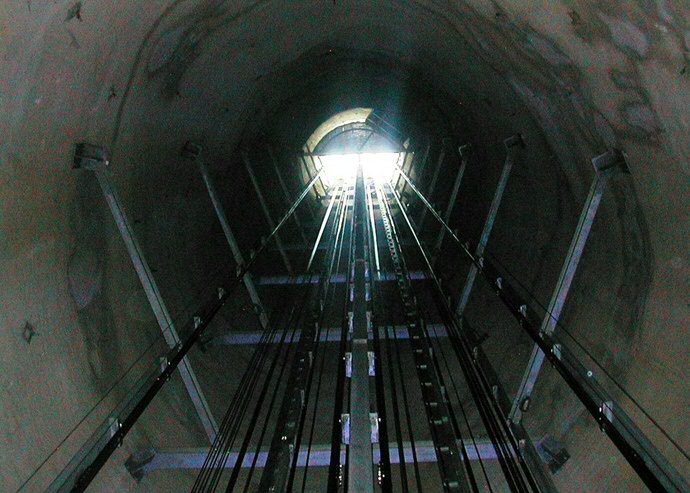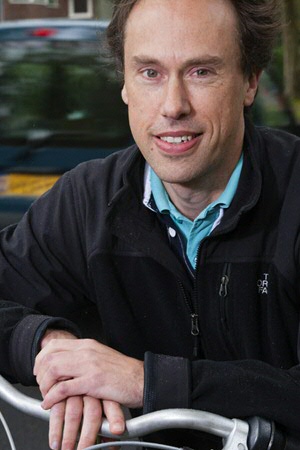The lift between life and death

The membrane of a cell forms the boundary of life itself. This thin, fatty mantle is the sleeve that keeps the contents of a cell firmly inside. Transport proteins within the membrane are vital for effecting contact and exchange with the outside world. This is the field that fascinates UG Professor of Biochemistry Dirk Jan Slotboom. This summer, he published two new discoveries.
By René Fransen
Research and education belong together at university. Dirk Slotboom only had time to talk about his research in the break between two lectures. ‘Can we do it in 30 minutes? That will give me more time to prepare.’ We can, because this impassioned researcher gets his message across in no time at all. He has been studying transport proteins since he started his PhD project at the UG in 1995. They are vital to life. ‘I trained as a chemist, so I tend to look at life from the reductionist angle. One of the aspects that characterizes life is the fact that it can only exist in separate compartments. Organisms can't live if the molecules aren't close together in the seclusion of a cell. And life is always out of balance. A system that is in balance with its environment is dead.’
The membrane serves as a boundary between the cell contents and the outside world. The transport proteins within the membrane play an important role in keeping the cell out of balance, and therefore alive. These proteins absorb building blocks, for example, and discharge waste or signal substances. The transport protein that Slotboom studied in his PhD research ensured that bacteria could absorb the amino acid glutamate. ‘This substance is an essential building block for proteins’, explains Slotboom. During his PhD research, he discovered that similar transport proteins were also present in humans. ‘Glutamate is a signal substance in our brains. Nerve cells discharge it to transmit stimuli to nearby cells. It then has to be reabsorbed quickly, because a prolonged stimulus could damage the cell.’ Problems getting rid of glutamate also play a role in certain neurological conditions, such as Huntington’s chorea and Parkinson's disease.

Cancer
But it isn't the role that transport proteins play in the development of diseases that has captured Slotboom's imagination, he adds: ‘We conduct fundamental research at universities.’ The fact that our findings often lead to practical applications in the long term is obviously important, but researchers are driven by a need to find out how life works. This summer, Slotboom published not one, but two articles presenting fundamental discoveries. Both had a practical twist. The first article described the structure of a transport protein that is particularly active in cancer cells. Slotboom and his colleagues used a new technique called cryo-electron microscopy to clarify the structure of the protein and gain more insight into its workings. This protein, ASCT2, absorbs the amino acid glutamine from the surroundings and transports it through the membrane as if in a lift. The new knowledge gleaned can help researchers to develop substances that will block the lift. The resulting blockade could kill cancer cells, which need large amounts of glutamine to survive.
Vitamin B12
The second article focused on a completely different transport protein, one used by bacteria to absorb vitamin B12. ‘The unusual part of our discovery was that we noticed that the transport protein activates the vitamin while absorbing it.’ Vitamin B12 usually carries cyanide, which blocks activation, so the human body has enzymes that remove the cyanide. ‘In the case of bacteria, the transport protein appears to remove the cyanide immediately.’ Here too, future applications are conceivable: the combination of transport and activation is unique to bacteria, so a substance that blocks the process may perhaps work in the same way as antibiotics. Bacteria are already used in the industrial-scale production of the vitamin B12 on sale at high street chemists. ‘Improving the discharge process will make it easier to harvest the vitamin.’ But the greatest impact of the fundamental work carried out by Slotboom since his PhD project is felt by his peers: ‘Although it probably doesn't appeal to the general public, my research has, for example, proved that membrane proteins aren't as static as we assumed. We thought that these proteins were jammed into the membrane with very little room for manoeuvre. But it turns out that transport proteins can make huge leaps, in fact all kinds of movements. People get very excited when I present these findings at conferences.’ Slotboom has been studying transport proteins for half of his life. Does he still enjoy it? ‘Absolutely’, he says with a wide grin. ‘Technical possibilities are often a limiting factor in this type of fundamental research. So every technical breakthrough opens up a brand-new world.’ Over the past two decades, he has seen huge advances in the possibilities of studying the structure of transport proteins. In addition, new techniques for monitoring individual molecules have been developed.
Cryo-electron microscope
‘We were able to write the article about the ASCT2 protein thanks to a hyper-modern cryo-electron microscope purchased by the Faculty and the University’, explains Slotboom. He is keen to stress that working on the bounds of possibilities is important. ‘This is what we try to pass on to students in our teaching at every level.’ But there's something he wants to get off his chest: ‘Good teaching relies on top-class research. But the UG doesn't have enough money for research. We have to acquire funding from the Netherlands Organisation for Scientific Research (NWO) or the European Research Council (ERC). This is a strange state of affairs, because if I don't get funding, my teaching suffers.’ Good research should be financed by basic university funding. ‘Research and education belong together.’
No shortage of ideas
The professor has no shortage of ideas when it comes to new research projects: ‘My ultimate aim is to examine individual transport proteins in living cells. We do this in isolated systems at the moment, but the cell is the environment in which the transport proteins do their work.’ He is fairly confident that this will eventually be possible. ‘I’ve applied for funding to conduct experiments in individual systems but after that, I hope to switch my focus to living cells!’
More news
-
17 December 2025
Ben Feringa wins Feynman Prize
-
11 December 2025
Stormy planets and an unexpected atmosphere
